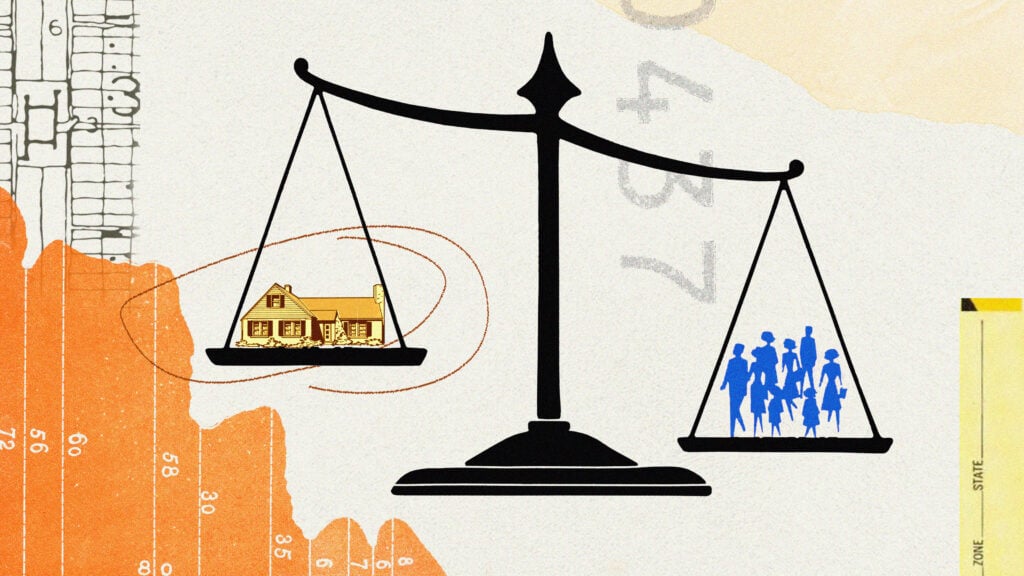Exclusive Report for Inman Intel Subscribers
This report is available exclusively to subscribers of Inman Intel, the data and research arm of Inman offering deep insights and market intelligence on the business of residential real estate and proptech. Subscribe today.
For a brief moment this month, mortgage rates plunged below the 6.5 percent mark — down significantly from a recent peak of 7.5 percent in April.
It wasn’t enough.
Consumers say they need rates to fall significantly lower than that before they’ll be willing to buy a home, according to a July survey of 3,000 working U.S. adults conducted by Inman Intel and Dig Insights.
And even once first-time buyers rejoin the fold, they are likely to face the same problem that plagued the housing market in the early pandemic homebuying frenzy: little new inventory to replace the houses that get scooped up.
For this report, Intel analyzed the responses of this survey, which included a group of more than 2,000 adults from across the country who said they were unlikely to buy a home in the next year.
TAKE THE INMAN INTEL INDEX SURVEY FOR AUGUST
Among other topics, Intel asked them how low rates would need to fall before they would seriously reconsider — an attempt to find a so-called “golden rate” that would spur renewed activity in home sales.
- Results from the Inman-Dig Insights consumer survey in July suggest that if rates fell from their recent 7 percent levels down to 5.5 percent, it could provide a meaningful boost to home sales.
- And if rates fell as low as 5.0 percent, the dam might break and release even more once-reluctant homebuyers onto the market.
But this emerging picture also hides some complex layers beneath the surface.
Instead of one clear number, the rate targets that emerged were quite different for renters than they were for homeowners. And coupled with the latest rate forecasts, these dueling dynamics could determine the complexion of the housing market not just for months, but potentially years.
Read Intel’s findings in the full report.
The Impact of Mortgage Rates
High mortgage rates remain a serious obstacle preventing consumers from entering the home market.
First, the top-level findings:
- Of the working adults who said they were “unlikely” to buy a home in the next 12 months, 1 in 10 said they would seriously consider changing their mind if mortgage rates fell as low as 5.5 percent.
- But that share doubles to 1 in 5 in a scenario where rates were to fall to 5.0 percent.
Although mortgage rates can be volatile, forecasts suggest that rates that low may still be years away.
- The Mortgage Bankers Association, for example, projects that rates are on track to hit 5.9 percent only by the fourth quarter of 2025, and may stay in that range through the following year as well.
These results should be taken with a few grains of salt.
For one thing, all of the so-called “unlikely buyers” that Intel surveyed were, by their own admission, not in the market for a home at this time. This means that some of their responses are merely hypothetical, not the result of research and kitchen-table math.
After sitting down with their budget and looking at home prices and monthly payments, it’s plausible that some respondents might give a different response than they provided to the survey.
Still, some clear consumer attitudes emerged in the survey data — with implications for what effect a lower-rate environment might have on transaction volume and buyer-seller dynamics in the years to come.
Future Dynamics of Mortgage Rates
Intel’s consumer survey results also illuminate a potential roadmap for the future dynamics between buyers and sellers as rates continue to descend.
Predictably, the survey found that renters are more responsive to small movements in mortgage rates. Current homeowners, on the other hand, need to see bigger declines to nudge them off the sidelines.
Intel tried to quantify just how big the gap was, and where the two groups might end up converging.
- If mortgage rates were to fall a bit further to 6.0 percent — nearly 2 points below their high point in October — it would persuade nearly 9 percent of reluctant-to-buy renters to change course and consider entering the home market.
- Less than half as big a share of reluctant buyers who already own a home would respond the same way. Only 4 percent of this group would show interest in the housing market, given the same 6.0 percent rate assumption.
This dynamic is not hard to explain.
The Impact of Rate Lock-In Effect on Homeowners
The rate lock-in effect has been a significant topic of discussion in the real estate industry and has been thoroughly examined by Intel. Many homeowners find themselves in one of two categories: either they have no debt on their home, or their current home loan has a much lower rate than what is currently available in the market. This dynamic could potentially balance out over time with churn and rate cuts, but Intel’s survey results suggest that it may persist even if rates fall significantly over the next two years.
If mortgage rates were to fall below 5.0 percent, it could convince 25 percent of renters to reconsider their reluctance to buy a home within the next 12 months. However, rates below 5 percent would only convince 16 percent of current homeowners who are hesitant to buy to reconsider. Rates in the 5 percent range, especially in the lower fives, could unlock a significant number of new buyers and increase housing inventory. However, even within that range, the demand from buyers may outpace the supply of existing homes on the market, leading to a seller’s market dynamic in many areas.
To avoid an imbalanced buyer frenzy, more new housing construction may be necessary. If builders are unable to keep up with demand, rates may need to fall to 4 percent or lower before both renters and homeowners warm up to the housing market at similar rates, according to Intel’s survey results. However, such a scenario is unlikely to occur in the near future.
About the Inman-Dig Insights Consumer Survey
The Inman-Dig Insights consumer survey was conducted from July 5 through July 7 to gather insights into the opinions and behaviors of Americans regarding homebuying. The survey included a diverse group of 3,000 American adults aged 24 to 65, employed either full-time or part-time, with a representative breakdown by age, gender, and region. The study maintained statistical rigor, and the results are largely representative of attitudes held by U.S. adults with full- or part-time jobs. Both Inman and Dig Insights are majority-owned by Toronto-based Beringer Capital. For more information, email Daniel Houston at [email protected].
https://www.inman.com/2024/08/19/pandemic-redux-buyers-sellers-disagree-on-the-golden-rate-intel/

